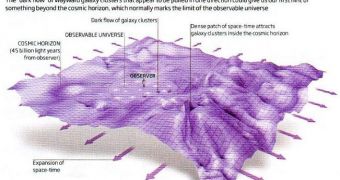Analysis of the large-scale flow of galaxies, clusters and superclusters are setting the grounds for new scientific theories that may have been cataloged as “heresies” just a few years back. Researchers are shedding serious doubts on the currently-accepted astronomical model explaining the Universe.
One thing that became apparent some time ago was that the Cosmos is expanding. Galaxies fly farther apart from each other every single day, even if some of them are gravitationally attracted to each other.
This attraction is the reason why clusters and superclusters are formed, but, overall, the tendency of every structure in the Universe is to expand and separate. This large-scale motion, dubbed the dark flow, can only be observed by taking focus off individual structures.
In other words, astrophysicists and cosmologists need to look for large patterns in the Universe, and not at individual interactions arising from the localized exertion of forces – such as for example the gravitationally-determined collision between Andromeda and the Milky Way.
A study published in 2008 proposed astronomers should look at the motion patterns of galaxy clusters, in order to identify what experts in charge of that work called aberrant flow. This meant they were looking for motions that were inconsistent with the general tendencies identified thus far.
This aberrant flow was also not accountable for by the force of gravity, the team proposed at the time. When such flows were discovered, the experts proposed that the inhomogeneities which created them existed prior to the onset of cosmic inflation.
This theory is in direct violation of the Lambda Cold Dark Matter (Lambda CDM) model, which proposes that inflation began shortly after the Big Bang, Universe Today reports.
The very term “dark flow” stems from the fact that experts cannot detect an origin for this aberrant bulk flow. It could be that it was caused by an excess mass – now located outside of the observable Cosmos – or by another, adjacent Universe, that is constantly colliding with our own.
The study, conducted by expert Alexander Kashlinsky, PhD, revolved around analyzing faint distortions found in the cosmic microwave background (CMB) by specialized spacecraft. The CMB is a layer of stray radiation permeating the Universe, that was produced shortly after the Big Bang.
But the expert's model does have its critics, who say that the motion of individual components cannot be ignored when analyzing the dark flow of the Universe. Maybe the best explanation of what we observe would be to combine the two models together, other scientists say.

 14 DAY TRIAL //
14 DAY TRIAL //